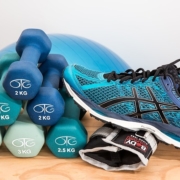How an old copywriting technique can get your ideas heard
During my workout this morning at the local YMCA, I noticed a couple of the other lifters gathered around a small placard on the decline bench press station.
I hit pause on The Fizzle Show (awesome podcast, by the way, you should subscribe) and wandered closer to hear what was going on.
The little card, as it turns out, was announcing a new rule: There is now a 10-minute time limit on all pieces of equipment in the free weights area.
Now, I get where they’re coming from. The weight room gets pretty crowded during the 6-7 a.m. time slot when I work out.
But there are roughly 30,000 people in the county where I live, and there are exactly three squat racks that I’ve been able to locate.
So it’s fair to say that demand exceeds supply, 10-minute limit or not. The Y really needs to suck it up and expand the free weights area.
This new rule really got under my skin. Three times a week I walk past rows of half unused cable machines and cardio equipment as I make my way back to the little corner where they’ve quarantined off the free weights. The balance of equipment in the fitness center is out of whack, and instead of fixing it they’re just telling everyone to hurry up.
I decided to email the Y to complain.
As I sat down at my keyboard, I wanted to just rant about how unfair the whole thing was, and how they aren’t listening to their members.
But instead, I took a deep breath and decided to try to apply some of the copywriting principles I’ve been studying.

One of my favorite copywriting formulas is the Problem Agitate Solve structure, which I first learned from Dan Kennedy.
In this formula, you start by calling out a problem or fear that plagues your intended reader. The more raw the problem is, the better.
Then, you get a big ol’ 4 lb. box of Morton iodized table salt–you know, the kind that’s all nice and fine–and you pour the entire thing on that wound. And then you rub it around for a while, until you’ve worked the salt into all the little nooks and crannies…
OK, that’s pretty gross. I know it sounds mean, but before you can convince someone to take an action that will benefit them, you need to get their emotions involved. You need to remind them that they have a problem, even if it’s not at the forefront of their mind right now.
Finally, once they’ve relived their distress for a while, they’re ready for you to show them the way out.
I like this formula because it’s relatively easy to remember and apply.
I also like it because it helps me shift from thinking about what I want to what my readerwants. Before you can even start to use Problem Agitate Solve, you have to figure out what pains and fears your audience is dealing with.
So I tried to put myself in the shoes of the folks running the fitness center.
What scares gym administrators more than anything?
I’ve never run a gym myself, but I’m pretty sure I know the answer:
Lawsuits.
One of the reasons many fitness centers have switched to machines over freeweights is that they believe users are less likely to get injured while using them.
I decided to play up the injury angle make an argument that the 10-minute time limit was dangerous.
Here’s the email I sent. Can you see each of the elements of the Problem Agitate Solve formula?
Subject: Could the new free weights policy lead to more injuries?
Hi!
During my workout this morning, I happened to notice the new 10-minute time limit posted on all of the equipment in the free weights section of the fitness center.
I wanted to voice my concern that this well-intentioned policy could lead to more Y members getting hurt.
Ten minutes seems like a reasonable limit, since the weight room does get crowded during peak times and lifters sometimes need to wait to use the equipment.
But 10 minutes is just barely enough to squeeze in three work sets, if you only rest for 1 minute between sets. Lifters need to do several warm up sets before they’re ready to do their heavy sets, or they risk serious injury. The 10 minute limit doesn’t leave enough time for that.
Muscle pulls and tears are bad enough, but the new policy will also encourage people to rush during dangerous exercises like squatting and bench pressing, which could lead to life-threatening injuries.
The weight room does get crowded, but capping the amount of time people can spend on a piece of equipment isn’t the best solution.
I’d be happy to pay an increased membership fee if the Y would expand the free weight section to accommodate the growing demand. Another possible solution would be replacing some of the bench press stations with multi-purpose power cages with removable benches. These could be used for squatting, deadlifting, benchpressing, etc.
Thanks for providing a quality place to work out!
Josh
Maybe not Gary Halbert-level copy, but I’m betting my complaint at least gets a fair hearing now. This is a much better approach than just unleashing a personal rant.
Copywriting isn’t a skill that’s only useful for putting together ads and sales pages. Studying techniques like the Problem Agitate Solve formula has helped me become a more effective communicator in my day-to-day life.
If you’re interested in learning to write more persuasively, check out The Adweek Copywriting Handbook by Joe Sugarman or The Copywriter’s Handbook by Bob Bly. Either will give you a good grounding in the basics of copywriting.
About the author: Josh Earl

Writer, entrepreneur and software developer.His blog is primarily about the ups and downs of entrepreneurship. But also he writes about fitness and productivity. This post originally appeared at joshuaearl.com. Click here to view the original post by Josh Earl



